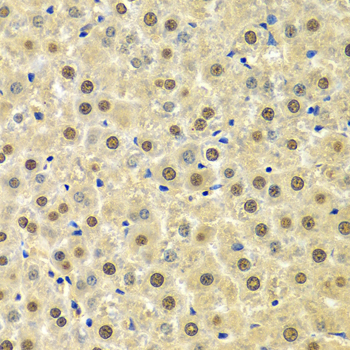Anti-SPHK1 Antibody (CAB0139)
- SKU:
- CAB0139
- Product type:
- Antibody
- Reactivity:
- Human
- Mouse
- Rat
- Host Species:
- Rabbit
- Isotype:
- IgG
- Antibody Type:
- Polyclonal Antibody
- Research Area:
- Cell Biology
Description
| Antibody Name: | Anti-SPHK1 Antibody |
| Antibody SKU: | CAB0139 |
| Antibody Size: | 20uL, 50uL, 100uL |
| Application: | WB IHC |
| Reactivity: | Human, Mouse, Rat |
| Host Species: | Rabbit |
| Immunogen: | Recombinant fusion protein containing a sequence corresponding to amino acids 50-384 of human SPHK1 (NP_001136074.1). |
| Application: | WB IHC |
| Recommended Dilution: | WB 1:500 - 1:2000 IHC 1:50 - 1:200 |
| Reactivity: | Human, Mouse, Rat |
| Positive Samples: | SW480, HeLa, Mouse kidney |
| Immunogen: | Recombinant fusion protein containing a sequence corresponding to amino acids 50-384 of human SPHK1 (NP_001136074.1). |
| Purification Method: | Affinity purification |
| Storage Buffer: | Store at -20°C. Avoid freeze / thaw cycles. Buffer: PBS with 0.02% sodium azide, 50% glycerol, pH7.3. |
| Isotype: | IgG |
| Sequence: | TLML TERR NHAR ELVR SEEL GRWD ALVV MSGD GLMH EVVN GLME RPDW ETAI QKPL CSLP AGSG NALA ASLN HYAG YEQV TNED LLTN CTLL LCRR LLSP MNLL SLHT ASGL RLFS VLSL AWGF IADV DLES EKYR RLGE MRFT LGTF LRLA ALRT YRGR LAYL PVGR VGSK TPAS PVVV QQGP VDAH LVPL EEPV PSHW TVVP DEDF VLVL ALLH SHLG SEMF AAPM GRCA AGVM HLFY VRAG VSRA MLLR LFLA MEKG RHME YECP YLVY VPVV AFRL EPKD GKGV FAVD GELM VSEA VQGQ VHPN YFWM VSGC VEPP PSWK PQQM PPPE EPL |
| Gene ID: | 8877 |
| Uniprot: | Q9NYA1 |
| Cellular Location: | Cell membrane, Cytoplasm, Nucleus |
| Calculated MW: | 42kDa/43kDa/51kDa |
| Observed MW: | 55kDa |
| Synonyms: | SPHK1, SPHK |
| Background: | The protein encoded by this gene catalyzes the phosphorylation of sphingosine to form sphingosine-1-phosphate (S1P), a lipid mediator with both intra- and extracellular functions. Intracellularly, S1P regulates proliferation and survival, and extracellularly, it is a ligand for cell surface G protein-coupled receptors. This protein, and its product S1P, play a key role in TNF-alpha signaling and the NF-kappa-B activation pathway important in inflammatory, antiapoptotic, and immune processes. Alternatively spliced transcript variants encoding different isoforms have been found for this gene. |
| UniProt Protein Function: | SPHK1: Catalyzes the phosphorylation of sphingosine to form sphingosine 1-phosphate (SPP), a lipid mediator with both intra- and extracellular functions. Also acts on D-erythro-sphingosine and to a lesser extent sphinganine, but not other lipids, such as D,L-threo-dihydrosphingosine, N,N-dimethylsphingosine, diacylglycerol, ceramide, or phosphatidylinositol. Interacts with ACY1. Binds to calmodulin. Interacts with SPHKAP. Widely expressed with highest levels in adult liver, kidney, heart and skeletal muscle. 2 isoforms of the human protein are produced by alternative splicing. |
| UniProt Protein Details: | Protein type:Lipid Metabolism - sphingolipid; EC 2.7.1.91; Kinase, lipid Chromosomal Location of Human Ortholog: 17q25.2 Cellular Component: synaptic vesicle; axon; cytoplasm; plasma membrane; nucleus; cytosol Molecular Function:D-erythro-sphingosine kinase activity; calmodulin binding; protein binding; DNA binding; protein phosphatase 2A binding; sphinganine kinase activity; magnesium ion binding; diacylglycerol kinase activity; ATP binding; NAD+ kinase activity Biological Process: protein folding; positive regulation of NF-kappaB import into nucleus; female pregnancy; positive regulation of mitotic cell cycle; signal transduction; positive regulation of neurotransmitter secretion; activation of NF-kappaB transcription factor; 'de novo' posttranslational protein folding; response to magnesium ion; positive regulation of fibroblast proliferation; regulation of interleukin-1 beta production; protein kinase C activation; positive regulation of smooth muscle contraction; inflammatory response; blood vessel development; sphingolipid metabolic process; sphingolipid biosynthetic process; cyclooxygenase pathway; calcium-mediated signaling; sphingosine metabolic process; cellular response to starvation; lipid phosphorylation; positive regulation of cell growth; response to ATP; positive regulation of angiogenesis; cellular protein metabolic process; positive regulation of protein ubiquitination; brain development; positive regulation of protein amino acid phosphorylation; response to progesterone stimulus; vascular endothelial growth factor receptor signaling pathway; sphingoid catabolic process; negative regulation of apoptosis; positive regulation of cell migration; response to amine stimulus |
| NCBI Summary: | The protein encoded by this gene catalyzes the phosphorylation of sphingosine to form sphingosine-1-phosphate (S1P), a lipid mediator with both intra- and extracellular functions. Intracellularly, S1P regulates proliferation and survival, and extracellularly, it is a ligand for cell surface G protein-coupled receptors. This protein, and its product S1P, play a key role in TNF-alpha signaling and the NF-kappa-B activation pathway important in inflammatory, antiapoptotic, and immune processes. Phosphorylation of this protein alters its catalytic activity and promotes its translocation to the plasma membrane. Alternative splicing results in multiple transcript variants encoding different isoforms. [provided by RefSeq, Sep 2017] |
| UniProt Code: | Q9NYA1 |
| NCBI GenInfo Identifier: | 17369329 |
| NCBI Gene ID: | 8877 |
| NCBI Accession: | Q9NYA1.1 |
| UniProt Related Accession: | Q9NYA1 |
| Molecular Weight: | |
| NCBI Full Name: | Sphingosine kinase 1 |
| NCBI Synonym Full Names: | sphingosine kinase 1 |
| NCBI Official Symbol: | SPHK1 |
| NCBI Official Synonym Symbols: | SPHK |
| NCBI Protein Information: | sphingosine kinase 1 |
| UniProt Protein Name: | Sphingosine kinase 1 |
| Protein Family: | Serine/threonine-protein kinase |
| UniProt Gene Name: | SPHK1 |
| UniProt Entry Name: | SPHK1_HUMAN |










